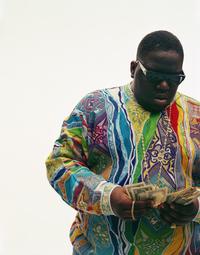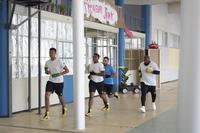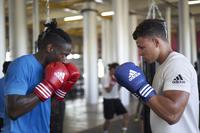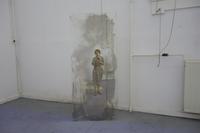Publisher Hanne Hagenaars wrote an essay about boxing and art for the Zine of Chapter 1NE, which you can read below.
There he stands with bared upper body, one hand defensive, the other in front of his chest protectively, but without the soft round boxing gloves that were mandatory from 1868. Poet-boxer Arthur Cravan (1878–1920) poses on the cover of his collection of poems, Steam whistle. The red letters dominate the image; it really is the perfect nickname for Cravan because anger was his thread of life.
Without his inflammatory language and provocations, Cravan would have been forgotten long ago. He was a Jack-of-all-trades and master of none, who found his destiny in art and in boxing. As a poet, he would start a reading with a number of pistol shots, before insulting his listeners at the top of his voice while shadowboxing. The audience clapped until their hands were sore but the press was negative. His moment of glory was the one time when he became middleweight boxing champion of France.
His kindred spirit, Armando – boxer, painter, poet – was more successful in every respect. He published the poetry collection, The Boxers, also with red letters on the cover, but he hadn’t come up with a single word of this himself. He highjacked boxers’ conversations and placed them on the pages as poems or short stories. Observing, without morality, without judgement.
“You know what was wrong with him? He couldn’t spar. When you spar, you don’t do each other in do you? (…) Go on then, kill me, asshole.”
“My goodness, that guy can pack a punch.
That surprised me too.
Tough lad.”
“Every blow I got in my mug hurt. As if a bomb was exploding in my head.”
Violence resonates in almost every sentence. A boxer dreams fear. For even if you are the biggest, the strongest, nobody eagerly looks forward to a brutal knockout, to a torn-open eyebrow, to stabbing pain.
‘Idiots only see something beautiful in beautiful things’, writes Cravan, ‘but the art is to see the beauty in ugly things too.’ Like receiving a blow. The beauty of a broken jaw, of the wonderful dark red colour of blood that gushes out. The cracking of a bone. Throwing up from fear.
Enduring fear is what the artist Danny de Vos does; that is his work of art. He voluntarily takes on the role of a victim and that seems unbearable. For example, he had his back painted blue, only to then have the paint removed with sandpaper. He let a professional boxer beat him up in the context of a performance on stage. Then you really do look fear straight in the eyes. Not that fear is afraid of Danny’s eyes. No, certainly not. But shouldn’t you drag such an artist off the stage? His wife Anne-Mie doesn’t think so: ‘The fact that he, as a man, puts himself into an artificial role of a victim is something I actually think is even justified. What Danny does, is a substitute purification ritual for a world in which there is a lot of injustice. Also, during a performance like this, so much creativity is released that it is contagious. I wouldn’t call it a party, but it gives me energy and inspiration.’
No, what is worthwhile is not always a party. Willingly taking a blow is an act of the mind. It takes nerve. Some boxers (and actors) feel the stage fright as mortal fear in their body. Sweating, vomiting, shaking like a leaf. And yet they still go on stage.
Artists are masters in overcoming fears: once they have a vision in mind, they will stop at nothing to reach it. For example, Vibeke Mascini was not at all fond of sport but, after she had seen the tip of the mountain Mont Blanc in the display case in Teylers Museum, lightning struck for her. Yes, she wanted that too: going to the highest point of the mountain to take a small piece home with her. She set up a strict training programme and began to drill herself ruthlessly. She didn’t reach the summit but she did manage to take some Alpine snow back with her in a thermos flask and she then let this melt above the North Sea using the warmth of her hands. We set out late because we had snow to dissolve for breakfast (2016), the soft pastel photo of that glorious moment was worth all the pain.
In art and boxing, it is all about the dialogue with people who don’t agree with you, a test of strength to hone yourself. The fight with your own resistance.
The greatest boxer of all time, Muhammad Ali, possessed amazing mental power. He refused to go to Vietnam to fight (‘I got no quarrel with them Vietcong’) and did not give in, despite the far-reaching consequences of his decision: Ali was no longer allowed to box in the US. He was called an artist, even more than a fighter. ‘Float like a butterfly, sting like a bee.’ A dancer, a dreamer, a poet and a boxer. In 1963 he released the long-playing record, I'm the Greatest, a mix of poetry and raps.
This is the legend of Muhammad Ali
The greatest fighter that ever will be
He talks a great deal and brags, indeed,
Of a powerful punch and a blinding speed.
And seen in this way, boxing is a holistic practice, a way to increase your self-awareness by training your body and mind. Because without mental power you cannot win a single battle.
The artist Aernout Mik made a video in which a few old men are fighting each other, powerlessly and wordlessly, like shadows of their former selves. The fight takes place in the kitchen. They are sparring. They have lost their strength but what counts now is the sum total of what they have won and achieved during their existence. Fighting your way through life without being afraid of getting a bloody nose is, after all, what it’s all about.







